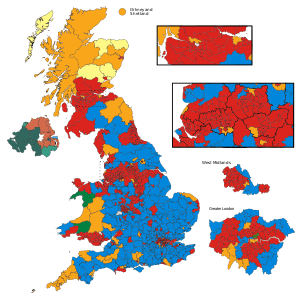Fifth Periodic Review of Westminster constituencies
The Fifth Periodic Review of Westminster constituencies was undertaken between 2000 and 2007 by the four boundary commissions for England, Scotland, Wales and Northern Ireland for the British Parliament. The changes to constituencies from three reviews were approved and took effect at the 2010 United Kingdom general election; that for Scotland took effect at the 2005 election.
Review process
The boundary commissions were required at the time by the Parliamentary Constituencies Act 1986 to review constituencies in their part of the United Kingdom every eight to twelve years. A Commission's recommendations from a review are based on the numbers of electors on the electoral register at the start of the review.
In Scotland, the recommendations were submitted in November 2004, and approved in February 2005.[1] In Wales, the recommendations were submitted on 31 January 2005, and approved on 11 April 2006.[2] In England, the recommendations were submitted on 31 October 2006, and approved on 13 June 2007.[3] In Northern Ireland, the recommendations were submitted on 14 September 2007 and approved on 11 June 2008.[4]
Changes

In England, the seats recommended by the commission generally do not cross boundaries of the largest local authority areas, i.e. counties (metropolitan or otherwise); however they may cross boundaries of unitary authority areas. York, for example, was consolidated into two constituencies, without electoral wards from North Yorkshire, whereas the unitary authorities of Berkshire have many cross-authority seats.
Some areas of England were awarded extra constituencies in the review, including Lancashire and Essex. Other review areas had one constituency removed, such as Tyne and Wear. Greater London as a whole was reviewed on a borough-by-borough basis, with two areas losing one constituency and central London gaining a constituency.
In Wales, the total number of seats remained at 40, although there was radical redrawing of boundaries in Clwyd and Gwynedd: e.g. Aberconwy, Arfon and Dwyfor Meirionnydd replaced Conwy, Caernarfon and Meirionnydd Nant Conwy respectively. Based on the 2006 statistics, Welsh constituencies have on average 16,000 fewer electors than those of England.
The Boundary Commission for Northern Ireland announced in 2006 that minor changes to the existing constituencies would take place in the east of the province.
In Scotland, the total number of seats dropped from 72 to 59. This was due to changes made by the Scotland Act 1998, applying the English electoral quota to Scotland. Unlike the other three countries, these changes took effect at the 2005 election. Three seats remained unchanged – East Renfrewshire (formerly named Eastwood), Orkney and Shetland, and Na h-Eileanan an Iar (formerly named Western Isles).[5]
These changes were the first major changes in the composition of UK Parliamentary constituencies since 1997.
The list of constituencies used in the 2010 general election, including changes resulting from these reviews, can be found at Constituencies in the United Kingdom general election, 2010. The Scottish constituencies were unchanged from the 2005 election.
One consequence of boundary reviews is the number of seats won by each party may change even if no individual voters vote for a different party.
New and abolished constituencies
It is not always easy to clearly identify newly created constituencies or those abolished during the review process.
The following constituencies are amongst those regarded as having been replaced during the review process:[6]
In negligible changes, South Leicestershire became a renamed Blaby; Romsey and Southampton North a negligibly altered Romsey; Rochester and Strood a renamed Medway; Conwy a scarcely altered Aberconwy; Gillingham and Rainham a virtually unaltered Gillingham; Plymouth Sutton and Devonport a little-changed Plymouth Sutton and Plymouth Moor View largely unchanged Plymouth Devonport. Derbyshire Dales almost coterminous with its forebear West Derbyshire and The Cotswolds was renamed Cotswold. The following seats are amongst those regarded as new creations:[6]
See also
- Sixth Periodic Review of Westminster constituencies
- List of United Kingdom Parliament constituencies
References
- "The Parliamentary Constituencies (Scotland) Order 2005", legislation.gov.uk, The National Archives, SI 2005/250
- "The Parliamentary Constituencies and Assembly Electoral Regions (Wales) Order 2006", legislation.gov.uk, The National Archives, SI 2006/1041
- "The Parliamentary Constituencies (England) Order 2007", legislation.gov.uk, The National Archives, SI 2007/1681
- "The Parliamentary Constituencies (Northern Ireland) Order 2008", legislation.gov.uk, The National Archives, SI 2008/1486
- Denver, David (14 April 2005). "Election set to test new limits". London: BBC News.
- Waller, Robert; Criddle, Byron (2007). The Almanac of British Politics (8th ed.). UK: Routledge. pp. 55–56. ISBN 978-0-415-37823-9.
Bibliography
- Fifth Periodical Report, Boundary Commission for England, ISBN 0-10-170322-8. Contains list of boundary changes in England.
- Fifth Periodical Report, Boundary Commission for Northern Ireland, ISBN 978-0-10-173212-3. Contains list of boundary changes in Northern Ireland.
- Fifth Periodical Report, Boundary Commission for Scotland, ISBN 9780101642729. Contains list of boundary changes in Scotland
- Fifth Periodical Report, Boundary Commission for Wales, ISBN 0-10-293660-9. Contains list of boundary changes in Wales.
.svg.png)